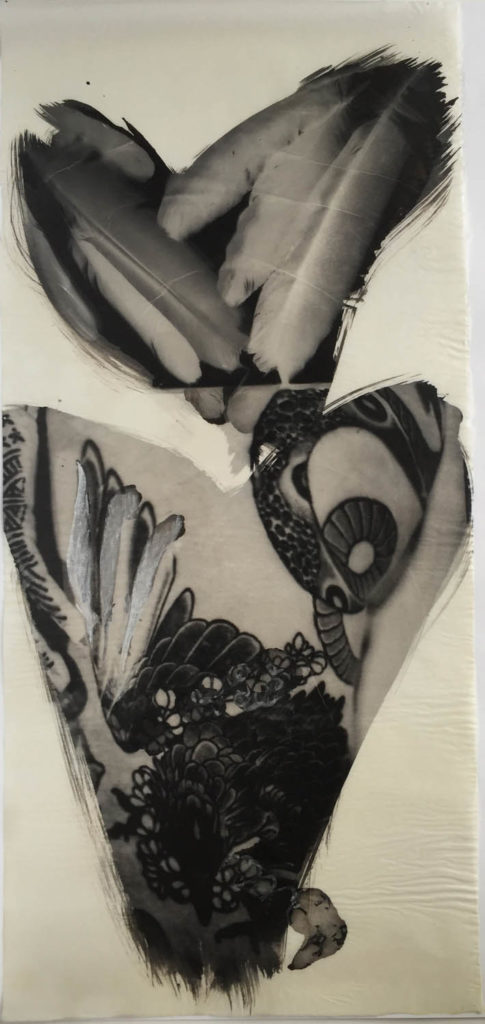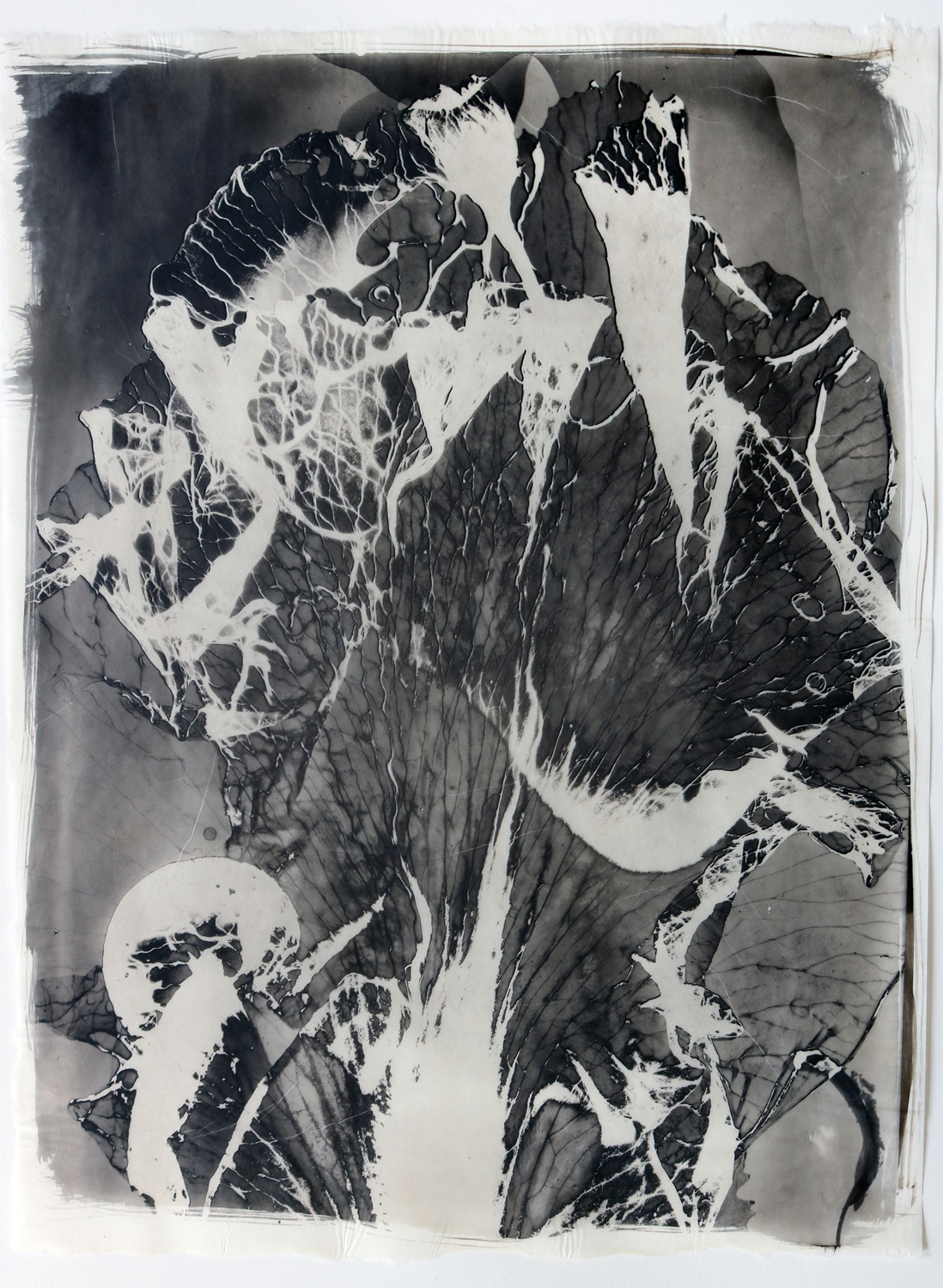As well as working with archival materials to produce my art works, I arrange for the framing to be archival. Each work is elegantly framed in white wood. The prints are hinged against the top backing board, so the work hangs like a textile.
This ensures that the delicacy of the translucent gampi paper will be protected and my clients receive works ready to hang.
Please click on the sentence below to view this PDF:
Through processes of transformation I present these palladium prints of objects from the ocean.
I have placed a few works from my current ocean portfolio in the above linked PDF. These works have grown from my sense of sanctuary in long walks at the ocean’s edge during this time of Covid lockdown.
Feeling wave upon wave wash over the sand moved me into the cyclic and expansive motion of the ocean. To express the ocean’s vastness and materiality, I pick up remnants of sea life washed onto the sand.
Placing these fragments of sea life directly into my enlarger, I make camera-free large 16 X 20 inch negatives to contact print using brushed palladium metal on translucent Japanese gampi paper and expose the negatives and paper using the direct rays of the sun.
When I place these fragments in my enlarger, the depth of field is similar to a lens that is wide open on a large format camera. Some details are sharply focused while others are softly embraced.
Using palladium allows for tonal distinctions of extreme subtlety. Sometimes when I paint the palladium on the paper, I paint only the shape of the object and leave the rest of the paper open. This I have done with the corals. Centering the corals allows for the concentration of their forms.
I am proud to have work in a group exhibition of artists hosted online by the Berlin Collectiv. Katia Hermann is the curator. My work is titled “Iris Sparks” and Katia wrote that my work is ‘scientific’ in that the cells and fibers of the Iris flower appear x-ray like. This is something I aim for in depicting the camera-free flora I chose.
To recall six foot waves, meadows, tidal surges, eight inch oysters that this was the land that the Gowanus canal replaced. Fortunately, we now have human creativity surging through this area of Brooklyn.
For my part in the Gowanus Open Studios 2019, one of my works is of a man reaching with his hand to feel the softness of a meadow plant. I will display this palladium print on Japanese gampi paper and a few other works as part of GOS2019 on the weekend of October 19th and 20th, from noon to 6 PM.
The location is King Killer Studio, 69 Second Ave. near 9th Street in the Gowanus section of Brooklyn.
The link to all the artists exhibiting is https://www.artsgowanus.org.
A phoenix is tattooed on her torso. Her hand rests on her hip. This is a window into hope. She is surrounded by burning, smoke and golden haze. Fires set to disrupt a rain forest habitat. Home for myriad insects, animals and hospitable for humans without destruction. No need for a monoculture of beef or the illegal logging of trees.
As if in flight, the insect and bird wings embrace her phoenix. If only this forest could rise from the ashes.
Artists in a current exhibition at The Brooklyn Museum communicate the problems of strife and political upheaval. Goya and Kathe Kollwitz made powerful works about the effects of war. Contemporary artist Titus Kaphar observed, in commenting on this exhibit, that we need to highlight these artists who resisted and communicated the troubles that they saw.
In my work I take small fragments of nature and make camera-free negatives. I combine these with photographs I have taken of people’s tattoos. The fragments of flora and fauna loom larger than the tattoos of my models in my works. I do this to compare our human scale to the expanse of the Earth. I hope that people viewing my work may comprehend the magnificent life around us.
This expression is a legacy of the Medieval world. At the Getty Center is an exhibit and a book titled: “Book of Beasts: The Bestiary in the Medieval World”. Curated by Elizabeth Morrison and Larisa Grollemond, this exhibit highlights how people in the Middle Ages perceived animals and explores the intersection of the animal and human worlds. Animals, both real and fantasy, were thought to have moral characteristics of good and evil. Hence, foxes were thought to be cunning in their pursuit of food, which included raiding hen houses of farmers. We also see the legacy of this visualization of animals in ours lives in the Harry Potter books and in the series “Game of Thrones”.
I pair the human world with animals to highlight the fragility of our current connection with nature. The human and the fox in this work here are united in their desire for the protection of the forest.
Recently I found a goose feather and as I walked, with the feather in my hand, I noticed how the feather responded to the wind. I felt how a bird feels as it flies.
At the Cooper Hewitt in New York City, there is an exhibit titled “Rebeca Mendez Selects” which highlights the fate of the Aztec ruler’s, Moctezuma II’s, private aviary at the hands of the Spanish conquerors. The Spanish set fire to his aviary and killed all the birds, which had come from all over the Americas. That this act demonstrates the destructive powers inherent in colonialism; it also illustrates the tensions arising from our conflicting impulses towards nature. This exhibit shows birds as sources of art, design and science and also discusses the effects of climate change and human avarice.

In the spring of 2017, my work was part of the exhibition “Tattooed New-York” at The New-York Historical Society. This exhibition traced the history of tattooing in New York starting with the native peoples to our times. It was curated by Cristian Petru Panaite.
My piece, “Hands Fly”, was exhibited with work that expands tattooing from the personal into art.
Tattooing was and is a part of human cultures globally.
My work is often inspired by the close relationship between tattoos and the honoring of plants and animals by other cultures, both past and present.
At the Brooklyn Museum is a small exhibition of jewelry, pottery, hunting tools and other objects of the indigenous peoples of the Americas in the Pre-Columbian time. One of the objects is a gold Chiriqui pendant of a spider whose legs end in human hands. This pendant served as an active extension of its owner, like tattoos, and a communicator of awe for a creature of nature.
An artist whose work includes spiders is Louise Bourgeois who saw spiders as elegant, fearsome and protective.










